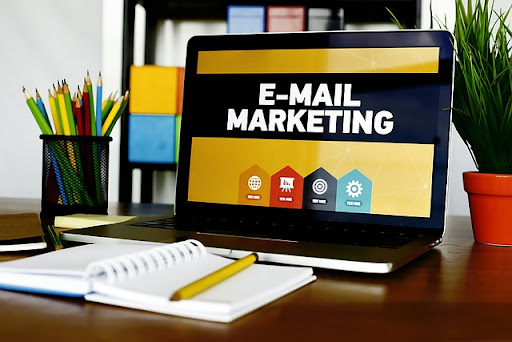Statistics suggest that email is the most successful digital lead nurturing channel, with a 78% lead conversion rate. Also, most email users (99%) log into their inboxes daily, with others signing in up to twenty times daily. These statistics imply that email marketing is among the best strategies your marketers can use to generate leads. It allows you to tailor your messages to a specific audience based on their demographics, behavior, and interests.
Email marketing is an effective tool for generating awareness, cultivating and maintaining customer relationships, and building credibility. It also helps increase sales. Email marketing lets you reach a broad audience cost-effectively and efficiently. It also allows you to monitor and measure your campaign’s results using tools like click-through, conversion, and open rates. This shows your marketing efforts’ performance, helping you make informed choices for better results.
Since email marketing is a scalable and flexible marketing strategy, you can easily adjust it to meet your business’s changing needs. As your business and audience expand, you can grow your subscriber list and segment the list into various groups. You can also build targeted campaigns to reach the group interested in your brand. With the right lead-generation tactics, email marketing can help drive more leads to your business.
Here are 10 email lead generation best practices.
Top 10 Email Lead Generation Best Practices 2023
1. Know your target audience
Discovering your target audience helps ensure your marketing resources are used effectively and ascertain better-focused messaging. It also helps develop a more solid referral base while ensuring most of your marketing efforts are directed at high-value prospects.
Learning your target audience enables you to understand their issues, interests, needs, and preferences. This makes it easy to segment them depending on their different attributes.
If you have an existing customer base, the data compiled from your CRM, client purchase history collected when integrating POS with eCommerce platforms, product reviews, and email lists can help you discover your audience. Studying your competitors and pinpointing their customers can help you create buyer personas for your business. Organize your customer data and model it to build correct buyer personas.
Defining your target audience, auditing your social media following, and interviewing existing customers can also help you know your audience.
2. Create valuable, high-quality content
Creating valuable, high-quality content is an excellent way to keep your leads engaged while nurturing them to convert. It informs, persuades, and makes your brand stand out in a competitive environment. With quality content, prospective leads are assured of value from their initial encounter with your business, building trust in your brand. To create the best email marketing content, start by specifying your goal- lead generation. This will help you adjust your content to get to the right audience.
Your email subject line should be catchy to grab your readers’ attention. Personalize your messaging to each prospect to ensure that it addresses them. Use a conversational tone to create a sense of familiarity with potential leads and enhance the possibility of your email being opened. Avoid starting your emails with a pitch because prospects might consider whatever you’re selling suspicious. Learn to ease prospects before pitching to them.
Consider offering your readers irresistible offers- something they’ll love. Identifying their interests, including freebies and promotions or regular newsletters, or product updates, can help you tailor your content to suit them. Leverage storytelling to:
- Develop an emotional connection with your audience
- Grab your reader’s attention
- Differentiate brand from competitors
- Boost engagement and increase open rates
- Highlight your services or products’ features and benefits
Create a sense of urgency in your email and use FOMO (Fear of Missing Out) to encourage prospective leads to take quick action. You should also optimize your CTAs and buttons and encourage feedback for more engagement. Creating good quality product descriptions for your email marketing campaign requires a content strategy. Content marketing experts like Remark can help you develop a plan suitable for your email lead-generation efforts.
3. Develop valuable opt-in offers
Valuable opt-in offers are an excellent way to entice prospective leads to share their contact details. Consider what your audience would want to know once they land on your website and provide it as a helpful piece of content potential leads get upon opting into a mailing list. The lead magnet you’re offering your readers should be valuable enough to convince them to give their contact information. You can offer them courses, e-books, video tutorials, checklists, newsletters, webinar sign-ups, or research reports.
4. Use lead generation automation
Lead generation is a time-consuming process and can sometimes be frustrating. Lead generation automation allows you to streamline it to make it more effective and efficient. Generating leads manually takes longer and may keep you from focusing on core business matters. However, automating lead generation automates manual tasks, freeing your time. Along with saving time, it also increases productivity and improves efficiency. This means more leads will be generated quicker and without much effort.
Precise data is vital for your lead generation procedure. Without it, discovering quality leads and targeting relevant audiences becomes challenging. Automating lead generation enhances data accuracy by minimizing manual activity-related mistakes and ascertaining that all entered data is consistent.
Lead generation automation solutions usually have in-built data verification and validation, helping prevent inaccuracies and boosting data quality. This increases confidence in your data while helping you make more informed decisions regarding your leads. Improved data accuracy helps generate more qualified leads, increase conversions, and ensure better business ROI.
Lead generation automation enhances lead qualification. This ensures your efforts are focused on leads most likely to convert. It also lets you answer your leads faster and more efficiently, offering an improved customer experience. Automation of your lead generation also ensures:
- Better data management
- Increased scalability
- Enhanced marketing automation
- Better data security
- Improved lead nurturing and follow-ups
5. Personalize your Messaging
Personalization is an effective tactic to entice potential leads to convert. It helps create more memorable and meaningful experiences for your lead. This builds credibility and trust, attracts more qualified leads, increases conversion chances, and improves email list engagement rates. For effective personalization, understanding your customers is vital.
Without a deep understanding of your target audience, what they require, and their motivation, delivering personalized experiences that resonate and convert is impossible. Technology and data are vital for lead generation personalization. Data from customer feedback, social media platforms, websites, and other sources can help build comprehensive customer profiles. It can also enable you to learn customer preferences and behavior while letting you deliver targeted and relevant experiences to each lead.
Conversely, technology gives you the lead prospecting tools to gather, keep, and customer data. Client details like name, demographics, interests, purchase frequency, what they love about your business, and brand interaction, are great for email personalization.
6. Invest in lead scoring
Lead scoring enables you to rank potential leads to determine the high-quality ones. Knowing the leads most likely to convert saves time and enhances your bottom line. Scoring your leads enables you to segment them depending on the details they provide. It also reduces your CPL (cost-per-lead) to ensure positive ROI.
Using lead scoring, you can prioritize sales prospecting by qualifying leads automatically according to the actions they take on your site. To maximize your lead scoring potential, determine your segments and personas’ features and identify your ideal customer’s characteristics. To identify top-quality leads:
- Define your sales qualified lead (SQL) criteria
- Assess a lead’s behavior to determine how close they’re to conversion
- Assign points to each action (actions nearing conversion should have high-value points)
- Analyze and adjust your lead scoring model to consistently achieve targeted leads
7. Time your emails
Timing your lead generation emails is essential because it significantly impacts your click-through and open rates. While email is an effective lead generation channel, sending your messages at the wrong time amounts to wasted marketing efforts, time, and resources. According to studies:
- The best days to send emails starting from the best ranked (based primarily on open rates) are Thursday, Tuesday, and Wednesday. Saturdays and Sundays are the worst days
- The most effective times to send your emails starting from the best are 10a.m, 9a.m, 8a.m, 1p.m, and 3p.m
The best time to send emails each day:
- Fridays- Open rates are usually higher between 10am and 11am. Around noon and at 2p.m is the second best time to send your emails
- Tuesday- 10 a.m. tops the chart. However, open rates remain steady all through the afternoon and go down after 6p.m
- Thursday- 10 a.m. Has the best open rates. The time may also differ between 9 a.m. and 11 a.m. However, the open rates reduce after 1p.m
- Monday- 10 a.m. is the peak time. Also, sending emails between 5p.m and 7p.m can give you more boost in click-through and open rates
- Wednesday- Higher open rates are at 10 a.m. Nevertheless, the rates see a significant drop after 6p.m
- Saturday- The best open rates are at 10a.m but slowly decline in the afternoons and evenings
- Sunday- High click-through rates are experienced at 10 a.m. However, they reduce in the afternoons and evenings
However, the best time to send emails may differ based on demographics, seasonal changes, email frequency, user experience, and product types.
8. Leverage social media platforms
While you may want a substantial social media following, it would be useless for your business if you can’t get into their inboxes or market and sell to them. Social media accounts can get deleted or suspended. If you’re yet to add your followers to your mailing list, you risk losing all possible leads. Hosting Twitter chats, creating lead-generating Facebook ads, leveraging LinkedIn groups, and advocating for your gated content can help generate leads.
You can also create a giveaway or contest to get your social media followers into your mailing list. Creating YouTube tutorials using CTA cards and SlideShare’s lead generation tool can also help build your email list. You can also use Google Hangouts to host webinars and create lead-generating stories on Instagram to grow your mailing list. With this list, targeting the right audience becomes easier.
9. Create compelling CTAs
Strong CTAs are essential for your email lead generation campaign to ensure your prospects take the action you want them to. They help create a targeted email list. Additionally, it helps ascertain that your audience knows the steps to take to continue connecting with your business. Without compelling CTAs, prospective leads may get stuck or not move forward in the funnel as quickly or consistently as they otherwise would. This is where business analytics can help you to achieve consistent leads with the help of data.
Statistics indicate that adding one CTA to your email can result in a 371% increase in clicks. To create solid CTAs that convert, use captivating action words and customize them to ensure they resonate with customer needs. This boosts the likelihood of them clicking on them. For your potential lead to notice your CTAs, ascertain they’re prominent. Create a sense of urgency to entice prospects to take action. Make your emails relatable to your audience and remain consistent and concise.
Your CTAs should offer value to the readers. Adding your unique selling proposition is likely to make your target audience convert. Building curiosity in your email CTAs is another way to grab readers’ attention. When writing lead-generating CTA, consider the following factors:
- Hook: The hook determines if your prospects will be attracted to the CTA
- Copy: This is a short explanation accompanying the hook. It should be brief and tell the audience the value they’ll gain upon converting. You can also use the copy to create a sense of urgency
- Design: Your CTA should be clearly and neatly designed to increase the possibility of converting
- Placement: Appropriate CTA positioning is vital for successful engagement. You can place them at the top-right, above the fold, footer, footer, end of content, pop-up, header, or bottom right
10. Consider A/B testing your lead generation campaign
A/B testing is an excellent way to boost your emails’ click-through and open rates. It increases the success chances of your email marketing. A/B testing involves sending two different email variations to a minor segment from your email list to determine which performs excellently for desired actions. This helps find a campaign that yields the best results based on open and click-through rates.
A/B testing your lead generation emails increases open rates, boosts click-through rates, and improves engagement. Additionally, it raises conversion rates and ROI and reduces unsubscribe rates. For A/B testing, you can use tools like Hubspot or ActiveCampaign.
Endnote
Email is an effective lead generation platform brands can leverage. Consider implementing these lead generation best practices for a healthier bottom line.




